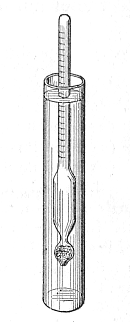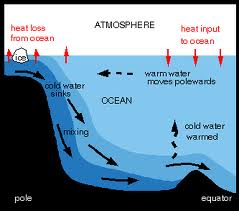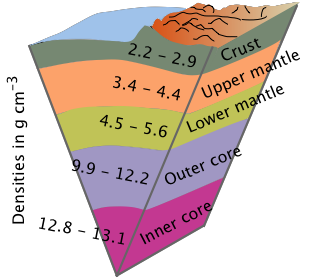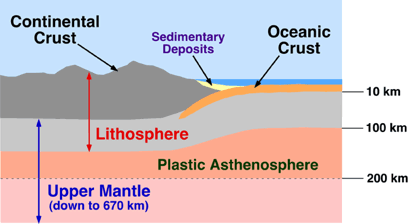1.8: Density
- Page ID
- 74205
\( \newcommand{\vecs}[1]{\overset { \scriptstyle \rightharpoonup} {\mathbf{#1}} } \)
\( \newcommand{\vecd}[1]{\overset{-\!-\!\rightharpoonup}{\vphantom{a}\smash {#1}}} \)
\( \newcommand{\dsum}{\displaystyle\sum\limits} \)
\( \newcommand{\dint}{\displaystyle\int\limits} \)
\( \newcommand{\dlim}{\displaystyle\lim\limits} \)
\( \newcommand{\id}{\mathrm{id}}\) \( \newcommand{\Span}{\mathrm{span}}\)
( \newcommand{\kernel}{\mathrm{null}\,}\) \( \newcommand{\range}{\mathrm{range}\,}\)
\( \newcommand{\RealPart}{\mathrm{Re}}\) \( \newcommand{\ImaginaryPart}{\mathrm{Im}}\)
\( \newcommand{\Argument}{\mathrm{Arg}}\) \( \newcommand{\norm}[1]{\| #1 \|}\)
\( \newcommand{\inner}[2]{\langle #1, #2 \rangle}\)
\( \newcommand{\Span}{\mathrm{span}}\)
\( \newcommand{\id}{\mathrm{id}}\)
\( \newcommand{\Span}{\mathrm{span}}\)
\( \newcommand{\kernel}{\mathrm{null}\,}\)
\( \newcommand{\range}{\mathrm{range}\,}\)
\( \newcommand{\RealPart}{\mathrm{Re}}\)
\( \newcommand{\ImaginaryPart}{\mathrm{Im}}\)
\( \newcommand{\Argument}{\mathrm{Arg}}\)
\( \newcommand{\norm}[1]{\| #1 \|}\)
\( \newcommand{\inner}[2]{\langle #1, #2 \rangle}\)
\( \newcommand{\Span}{\mathrm{span}}\) \( \newcommand{\AA}{\unicode[.8,0]{x212B}}\)
\( \newcommand{\vectorA}[1]{\vec{#1}} % arrow\)
\( \newcommand{\vectorAt}[1]{\vec{\text{#1}}} % arrow\)
\( \newcommand{\vectorB}[1]{\overset { \scriptstyle \rightharpoonup} {\mathbf{#1}} } \)
\( \newcommand{\vectorC}[1]{\textbf{#1}} \)
\( \newcommand{\vectorD}[1]{\overrightarrow{#1}} \)
\( \newcommand{\vectorDt}[1]{\overrightarrow{\text{#1}}} \)
\( \newcommand{\vectE}[1]{\overset{-\!-\!\rightharpoonup}{\vphantom{a}\smash{\mathbf {#1}}}} \)
\( \newcommand{\vecs}[1]{\overset { \scriptstyle \rightharpoonup} {\mathbf{#1}} } \)
\( \newcommand{\vecd}[1]{\overset{-\!-\!\rightharpoonup}{\vphantom{a}\smash {#1}}} \)
\(\newcommand{\avec}{\mathbf a}\) \(\newcommand{\bvec}{\mathbf b}\) \(\newcommand{\cvec}{\mathbf c}\) \(\newcommand{\dvec}{\mathbf d}\) \(\newcommand{\dtil}{\widetilde{\mathbf d}}\) \(\newcommand{\evec}{\mathbf e}\) \(\newcommand{\fvec}{\mathbf f}\) \(\newcommand{\nvec}{\mathbf n}\) \(\newcommand{\pvec}{\mathbf p}\) \(\newcommand{\qvec}{\mathbf q}\) \(\newcommand{\svec}{\mathbf s}\) \(\newcommand{\tvec}{\mathbf t}\) \(\newcommand{\uvec}{\mathbf u}\) \(\newcommand{\vvec}{\mathbf v}\) \(\newcommand{\wvec}{\mathbf w}\) \(\newcommand{\xvec}{\mathbf x}\) \(\newcommand{\yvec}{\mathbf y}\) \(\newcommand{\zvec}{\mathbf z}\) \(\newcommand{\rvec}{\mathbf r}\) \(\newcommand{\mvec}{\mathbf m}\) \(\newcommand{\zerovec}{\mathbf 0}\) \(\newcommand{\onevec}{\mathbf 1}\) \(\newcommand{\real}{\mathbb R}\) \(\newcommand{\twovec}[2]{\left[\begin{array}{r}#1 \\ #2 \end{array}\right]}\) \(\newcommand{\ctwovec}[2]{\left[\begin{array}{c}#1 \\ #2 \end{array}\right]}\) \(\newcommand{\threevec}[3]{\left[\begin{array}{r}#1 \\ #2 \\ #3 \end{array}\right]}\) \(\newcommand{\cthreevec}[3]{\left[\begin{array}{c}#1 \\ #2 \\ #3 \end{array}\right]}\) \(\newcommand{\fourvec}[4]{\left[\begin{array}{r}#1 \\ #2 \\ #3 \\ #4 \end{array}\right]}\) \(\newcommand{\cfourvec}[4]{\left[\begin{array}{c}#1 \\ #2 \\ #3 \\ #4 \end{array}\right]}\) \(\newcommand{\fivevec}[5]{\left[\begin{array}{r}#1 \\ #2 \\ #3 \\ #4 \\ #5 \\ \end{array}\right]}\) \(\newcommand{\cfivevec}[5]{\left[\begin{array}{c}#1 \\ #2 \\ #3 \\ #4 \\ #5 \\ \end{array}\right]}\) \(\newcommand{\mattwo}[4]{\left[\begin{array}{rr}#1 \amp #2 \\ #3 \amp #4 \\ \end{array}\right]}\) \(\newcommand{\laspan}[1]{\text{Span}\{#1\}}\) \(\newcommand{\bcal}{\cal B}\) \(\newcommand{\ccal}{\cal C}\) \(\newcommand{\scal}{\cal S}\) \(\newcommand{\wcal}{\cal W}\) \(\newcommand{\ecal}{\cal E}\) \(\newcommand{\coords}[2]{\left\{#1\right\}_{#2}}\) \(\newcommand{\gray}[1]{\color{gray}{#1}}\) \(\newcommand{\lgray}[1]{\color{lightgray}{#1}}\) \(\newcommand{\rank}{\operatorname{rank}}\) \(\newcommand{\row}{\text{Row}}\) \(\newcommand{\col}{\text{Col}}\) \(\renewcommand{\row}{\text{Row}}\) \(\newcommand{\nul}{\text{Nul}}\) \(\newcommand{\var}{\text{Var}}\) \(\newcommand{\corr}{\text{corr}}\) \(\newcommand{\len}[1]{\left|#1\right|}\) \(\newcommand{\bbar}{\overline{\bvec}}\) \(\newcommand{\bhat}{\widehat{\bvec}}\) \(\newcommand{\bperp}{\bvec^\perp}\) \(\newcommand{\xhat}{\widehat{\xvec}}\) \(\newcommand{\vhat}{\widehat{\vvec}}\) \(\newcommand{\uhat}{\widehat{\uvec}}\) \(\newcommand{\what}{\widehat{\wvec}}\) \(\newcommand{\Sighat}{\widehat{\Sigma}}\) \(\newcommand{\lt}{<}\) \(\newcommand{\gt}{>}\) \(\newcommand{\amp}{&}\) \(\definecolor{fillinmathshade}{gray}{0.9}\)Most of us have long understood that "oil is lighter than water", or that iron is "heavier" than sugar. But in making such statements, we are implicitly comparing equal volumes of these substances: after all, we know that a cup of sugar will weigh more than a single ordinary steel nail.
Mass and volume are measures of the quantity of a substance, and as such are defined as extensive properties of matter. The ratio of two extensive properties is always an intensive property — one that characterizes a particular kind of matter, independently of its size or mass. It is this ratio, (mass ÷ volume), that we are concerned with in this Module.

These plots show how the masses of three liquids vary with their volumes. Notice that
- the plots all have the same origin of (0,0): if the mass is zero, so is the volume;
- the plots are all straight lines, which signify direct proportionality.
The only difference between these plots is their slopes. Denoting mass and volume by \(m\) and \(V\) respectively, we can write the equation of each line as \(m = \rho V\), where the slope \(\rho\) (Greek lower-case rho) is the proportionality constant that relates mass to volume. This quantity \(\rho\) is known as the density, which is usually defined as the mass per unit volume:
\[\rho = \dfrac{m}{V}.\]
The volume units milliliter (mL) and cubic centimeter (cm3) are identical and are commonly used interchangeably.
The general meaning of density is the amount of anything per unit volume. What we conventionally call the "density" is more precisely known as the "mass density". However, one can also construct other densities like a "charge density" for example.
Density can be expressed in any combination of mass and volume units; the most commonly seen units are grams per mL (g mL–1, g cm–3), or kilograms per liter.
1 kg m–3 = 10–3 g L–1 = 62.4 lb ft–3
Example \(\PageIndex{1}\):
Ordinary commercial nitric acid is a liquid having a density of 1.42 g mL–1, and contains 69.8% HNO3 by weight. a) Calculate the mass of HNO3 in 800 ml of nitric acid. b) What volume of acid will contain 100 g of HNO3?
SOLUTION
The mass of 800 mL of the acid is (1.42 g mL–1) × (800 mL) = 1140 g. The weight of acid that contains 100 g of HNO3 is
\[\dfrac{100\; g}{0.698} = 143 \;g \]
and will have a volume of
\[\dfrac{143\; g}{1.42\, g\, mL^{–1}} = 101\; mL\]
Specific Volume and Specific gravity
It is sometimes more convenient to express the volume occupied by a unit mass of a substance. This is just the inverse of the density and is known as the specific volume.
Example \(\PageIndex{2}\):
A glass bulb weighs 66.3915 g when evacuated, and 66.6539 g when filled with xenon gas at 25°C. The bulb can hold 50.0 mL of water. Find the density and specific volume of xenon under these conditions.
SOLUTION
The mass of xenon is found by difference: (66.6539 – 66.3915)g = 0.2624 g. The density ρ = m/V = (0.2624 g)/(0.050 L) = 5.248 g L–1. The specific volume is 1/(5.248 g L–1 = 0.190 L g–1.
quantity that is very closely related to density, and which is frequently used in its place, is specific gravity. Specific gravity is the ratio of the mass of a material to that of an equal volume of water. Because the density of water is about 1.00 g mL–1, the specific gravity is numerically close to that of the density, but being a ratio, it is dimensionless.
The presence of "volume" in this definition introduces a slight complication: volumes are temperature-dependent owing to thermal expansion. At 4°C, water has its maximum density of almost exactly 1.000 g mL–1, so if the equivalent volume of water is assumed to be at this temperature, then the density and specific gravity can be considered numerically identical. In making actual comparisons, however, the temperatures of both the material being measured and of the equivalent volume of water are frequently different, so in order to specify a specific gravity value unambiguously, it is necessary to state the temperatures of both the substance in question and of the water. Thus if we find that a given volume of a substance at 20° C weighs 1.11 times as much as the same volume of water measured at 4°C, we would express its specific gravity as

Although most chemists find density to be more convenient to work with and consider specific gravity to be rather old-fashioned, the latter quantity is widely used in many industrial and technical fields ranging from winemaking to urinalysis.
Densities of common substances
The range of densities encountered in the world spans a remarkably wide range, from essentially zero in outer space to the unimaginably huge values found in stellar bodies. These very high densities represent the ultimate limits of how much mass can be packed into a given volume. The following chart will give you some feeling for the values of density found in nature generally (top), in common solids (middle), and in gases and liquids (bottom). Please note that in order to depict reasonably wide ranges of values in limited space, the density scales are logarithmic; thus zero on these scales corresponds to the density of water (100 = 1 g cm–3). Densities listed for ordinary substances (including gases) are mostly those at around 20° C.
Notes

- The world's lowest-density class of solids, invented in 2011.
- Remove the water from a colloidal gel, and you get an aerogel, sometimes called "solid smoke". Besides its extremely low density, many aerogels exhibit remarkably low thermal conductivity.
- The Sun's very low average density may surprise you. But bear in mind that it is all very hot gas. The density at the Sun's center is estimated to be about 160 g/cm3.
- No surprise that the lightest element forms the lowest density solid of any pure substance. Melts at 14 K. First prepared by James Dewar in 1899.
- This ultrafine form of SiO2 is found in everything from toothpaste to coffee creamer.
- Osmium's density is just a hair greater than that of indium. Why do these elements win out over the heavier ones? Blame it on the lanthanide contraction
- Squeeze the sun down into the size of the earth, and you get a white dwarf. This will eventually happen to the sun after it runs out of hydrogen fuel.
- These exotic beasts concentrate their mass at a zero-radius point, so in a sense possess infinite density. The value given here assumes a volume defined by the event horizon. Black holes are the ultimate fate of the most massive stars.
- Collapse of stars between 1.4 and 2 times more massive than the sun squeezes electrons and protons into each other, rendering much of the star's matter into a ball of neutrons having a radius of only a few kilometers.
Solids, liquids and gases
In general, gases have the lowest densities, but these densities are highly dependent on the pressure and temperature which must always be specified. To the extent that a gas exhibits ideal behavior (low pressure, high temperature), the density of a gas is directly proportional to the masses of its component atoms, and thus to its molecular weight. Measurement of the density of a gas is a simple experimental way of estimating its molecular weight.



Liquids encompass an intermediate range of densities. Mercury, being a liquid metal, is something of an outlier. Liquid densities are largely independent of pressure, but they are somewhat temperature-sensitive.
The density range of solids is quite wide. Metals, whose atoms pack together quite compactly, have the highest densities, although that of lithium, the highest metallic element, is quite low. Composite materials such as wood and high-density polyurethane foam contain void spaces which reduce the average density.
How the temperature affects density
All substances tend to expand as they are heated, causing the same mass to occupy a greater volume, and thus lowering the density. For most solids, this expansion is relatively small, but it is far from negligible; for liquids, it is greater. The volumes of gases, as you may already know, are highly temperature-sensitive, and so, of course, are their densities.
What is the cause of thermal expansion? As molecules acquire thermal energy, they move about more vigorously. In condensed phases (liquids and solids), this motion has the character of an irregular kind of bumping or jostling that causes the average distances between the molecules to increase, thus leading to increased volume and smaller density.
Densities of the elements
One might expect the densities of the chemical elements to increase uniformly with atomic weight, but this is not what happens; density depends on the volume as well as the mass, and the volume occupied by a given mass of an element, and these volumes can vary in a non-uniform way for two reasons:
The sizes (atomic radii) follow the zig-zag progression that characterizes the other periodic properties of the elements, with atomic volumes diminishing with increasing nuclear charge across each period.
Density of water
Nature has conveniently made the density of water at ordinary temperatures almost exactly 1.000 g/mL (1 kg/L). Water is subject to thermal expansion just as are all other liquids, and throughout most of its temperature range, the density of water diminishes with temperature. However, water is famously exceptional over the temperature range 0-4° C, where raising the temperature causes the density to increase, reaching its greatest value at about 4°C.

The 4° density maximum is one of many "anomalous" behaviors of water. As you may know, the H2O molecules in liquid and solid water are loosely joined together through a phenomenon known as hydrogen bonding. Any single water molecule can link up to four other H2O molecules, but this occurs only when the molecules are locked into place within an ice crystal. This is what leads to a relatively open lattice arrangement, and thus to the relatively low density of ice.
Notice the greater openness of the ice structure which is necessary to ensure the strongest degree of hydrogen bonding in a uniform, extended crystal lattice. The more crowded and jumbled arrangement in liquid water can be sustained only by the greater amount thermal energy available above the freezing point.
When ice melts, thermal energy begins to overcome the hydrogen-bonding forces so that each H2O molecule, instead of being permanently connected to four neighbors, is now only linked to an average of three other molecules through hydrogen bonds that continually break and re-form. With fewer hydrogen bonds, the geometrical requirements that formerly mandated a more open structural arrangement now diminish, so the entire network tends to collapse, rendering the water more dense. As the temperature rises, the fraction of H2O molecules that occupy ice-like clusters diminishes, contributing to the rise in density that is seen between 0° and 4°.
| Example 3 |
|---|
|
Suppose that you place 1000 mL of pure water at 25°C in the refrigerator and that it freezes, producing ice at 0°C. What will be the volume of the ice? SOLUTION From the graph above, the density of water at 25°C is 0.9997 kg L–1, and that of ice at 0°C 0.917 g L–1. |
How is density measured?
The most obvious way of finding the density of a material is to measure its mass and its volume. This is the only option we have for gases, but observing the mass of a fixed volume of a liquid is time-consuming and awkward, and measuring the volumes of solids whose shapes are irregular or which are finely divided is usually impractical.
Liquids: the hydrometer
 The traditional hydrometer is a glass tube having a weighted bulb near the bottom. The hydrometer is lowered into a container of the liquid to be measured, and comes to a rest with the upper part protruding above the liquid surface at a height (read from a calibrated scale) that depends on the density of the liquid. This will only work, of course, if the overall density of the hydrometer itself is smaller than the density of the liquid to be measured. For this reason, hydrometers intended for general use come in sets. Because liquid densities are temperature dependent, hydrometers intended for precise measurements also contain an internal thermometer so that this information can be collected in the event that temperature corrections will be made.
The traditional hydrometer is a glass tube having a weighted bulb near the bottom. The hydrometer is lowered into a container of the liquid to be measured, and comes to a rest with the upper part protruding above the liquid surface at a height (read from a calibrated scale) that depends on the density of the liquid. This will only work, of course, if the overall density of the hydrometer itself is smaller than the density of the liquid to be measured. For this reason, hydrometers intended for general use come in sets. Because liquid densities are temperature dependent, hydrometers intended for precise measurements also contain an internal thermometer so that this information can be collected in the event that temperature corrections will be made.
Owing to the ease with which they can be observed, densities are widely employed to estimate the composition or quality of liquid mixtures or solutions, and in some cases determine their commercial value. This has given rise to many kinds of hydrometers that are specialized for specific uses:
- Saccharometer – used by winemakers and brewers to measure the sugar content of a liquid
- Alcoholometer – measures the alcoholic content of a liquid
- Salinometer – measures the "salinity" (salt content) of brine or seawater
- Lactometer - measures the specific gravity of milk products
Hydrometers for general purpose use are normally calibrated in units of specific gravity, but often defined at temperatures other than 25°C. A very common type of calibration is in "degrees" on various arbitrary scales, of which the best known are the Baume scales. Special-purpose hydrometer scales can get quite esoteric; thus alcohol hydrometers may directly measure percentage alcohol by weight on a 0–100% scale, or "proof" (twice the volume-percent of alcohol) on a 0-200 scale.
Solids
Measuring the density of a solid that is large enough to weigh accurately is largely a matter of determining its volume. For an irregular solid such as a rock, this is most easily done by observing the amount of water it displaces. A small vessel having a precisely determined volume can be used to determine the density of powdered or granular samples. The vessel (known as a pycnometer) is weighed while empty, and again when filled; the density is found from the weight difference and the calibrated volume of the pycnometer. This method is also applicable to liquids and gases.
In forensic work it is often necessary to determine the density of very small particles such as fibers, flakes of paint or metal, or grains of sand. Neither the weight nor volumes of such samples can be determined directly, so the simplest solution is to place the sample in a series of liquids of different densities, and see if it floats, sinks, or remains suspended within the liquid. A more sophisticated method is to layer two liquids in a vertical glass tube and allow them to slowly mix, creating a density gradient. When a particle is dropped into the tube, it sinks to a depth that matches its density.
Applications of density
Archimedes' Principle
The most famous application of buoyancy is due to Archimedes of Syracuse around 250 BCE. He was asked to determine whether the new crown that King Hiero II had commissioned contained all the gold that he had provided to the goldsmith for that purpose; apparently he suspected that the smith might have set aside some of the gold for himself and substituted less-valuable silver instead.

According to legend, Archimedes devised the principle of the “hydrostatic balance” after he noticed his own apparent loss in weight while sitting in his bath. The story goes that he was so enthused with his discovery that he jumped out of his bath and ran through the town, shouting "eureka" to the bemused populace.
| Example 8 |
|---|
|
If the weight of the crown when measured in air was 4.876 kg and its weight in water was 4.575 kg, what was the density of the crown? SOLUTION The volume of the crown can be found from the mass of water it displaced, and thus from its buoyancy: (4876 – 4575) g / (1.00 g cm–3) = 301 cm3. The density is then (4876 g) / (301 cm3) = 16.2 g cm–3 The densities of the pure metals: silver = 10.5, gold = 19.3 g cm–3, |
Estimating the size of an atom
One of the delights of chemical science is to find way of using the macroscopic properties of bulk matter to uncover information about the microscopic world at the atomic level. The following problem example is a good illustration of this.
| Example 9 |
|---|
|
Estimate the diameter of the neon atom from the following information:
SOLUTION This problem can be divided into two steps.
The accepted [van der Waals] atomic radius of neon is 154 pm, corresponding to a diameter of about 310 pm. This estimate is surprisingly good, since the atoms of a liquid are not really confined to orderly little boxes in the liquid. |
Seasonal stratification and turnover in lakes
 =
=
Water's density maximum at 4°C has some interesting consequences in the aquatic ecology of lakes. In all but the most shallow lakes, the water tends to be stratified, so that for most of the year, the denser water remains near the bottom and mixes very little with the less-dense waters above. Because water has its density maximum at 4°C, the waters of deep lakes (and of the oceans) usually stay around 4°C at all times of the year . In the summer this will be the coldest water, but in the winter, the surface waters lose heat to the atmosphere and if they cool below 4°, they will be colder than the more dense waters below.
When the weather turns cold in the fall, the surface waters lose heat and cool to 4°C. This more dense layer of water sinks to the bottom, displacing the water below, which rises to the surface and restores nutrients that were removed when dead algae sank to the bottom. This “fall turnover” renews the lake for the next season.
The global oceanic "conveyor belt": Thermohaline circulation
The density of water containing dissolved salts is greater than that of pure water, and the density increases with the salt concentration (salinity). This seemingly trivial fact exerts a profound effect on our planet, driving the circulation in the oceans and affecting the climate and oceanic productivity.
Two Oceans
The world's oceans consist of two huge reservoirs, one on top of the other. The upper ocean comprises about 5% of the total volume; owing to turbulence produced by wind and waves, its vertical profile is fairly uniform in composition and temperature. Its currents are driven mainly by surface winds which exert little effect below about 100 meters or so.
The remaining 95% of the ocean's volume resides in a deeper and colder layer. The temperature and density of this bottom ocean increase with depth, the coldest (4° C, and therefore the most dense) water being at the sea floor. So unlike the well-mixed upper ocean, the bottom one is stratified, similarly to that of lakes in cold winters.
Owing to this permanent stratification, mixing between the upper and lower oceans is very slow; only about 0.01% moves between the two layers per year. The mean residence time of a water molecule in the deep layer is about 1600 years. If it were not for cold polar winters, there would be very little movement of water in the bottom ocean.

However, when seasonal ice begins to form in the polar regions,"holes" open up that allow water to drain from the upper ocean to the lower one. Because the salts dissolved in seawater cannot be accommodated within the ice structure, they are largely excluded from the new ice and remain in solution. This increases the salinity, and thus the density, of the surrounding unfrozen water, causing it to sink into the bottom ocean
There are two major locations at which surface waters enter the deep ocean. The northern entry point is in the Norwegian Sea off Greenland; this water forms a mass known as the North Atlantic Deep Water (NADW) which flows southward across the equator. Most of the transport into the deep ocean takes place in the Weddell Sea off the coast of Antarctica. The highly saline water flows down the submerged Antarctic Slope to begin a 5000-year trip to the north across the bottom of the ocean. This is the major route by which dissolved CO2and O2 (which are more soluble in this cold water) are transported into the deep ocean where it forms a water mass known as the Antarctic Bottom Water (AABW) which can be traced into all three oceans.
Deep Ocean Currents
As the cold water drains into the deep ocean. it spills over ridges and valleys, creating huge undersea cascades which rival the greatest terrestrial waterfalls in height and the largest rivers in volume. These deep water currents are much slower than the surface currents; estimated rates are of the order of kilometers per month, in contrast to the few kilometers per hour of surface waters.
Coastal Upwelling
As the cold water begins to fill up the bottom ocean, it displaces the less dense bottom water, pushing it back up into the upper ocean. This recirculation occurs to a small extent in many regions, but is especially pronounced along continental coasts where prevailing winds tend to roll surface waters over.

Figure 1: [NASA]
The deep ocean contains few organisms to deplete the water of the nutrients it receives from the remains of the dead organisms floating down from above; this upwelled water is therefor exceptionally rich in nutrients, and strongly encourages the growth of new organisms that extend up the food chain to fish. For example, the upwelling that occurs off the west coast of South America is responsible for the Peruvian fishing and guano fertilizer industry.
About every seven years the prevailing winds that help drive upwelling disappear for a while, allowing warm equatorial waters to move in. This phenomenon is known as El Niño and it results in massive kills of plankton and fish. Decomposition of the dead organisms reduces the oxygen content of the water, causing the death of still more fish, and allowing reduced compounds such as hydrogen sulfide to accumulate.
Density and the Structure of the Earth
The grandest scale in which density and buoyancy reveal themselves lies in the structure of the earth and its continents.
Formation and Differentiation of the Earth
The sun formed by gravitational attraction of the the massive amounts of interstellar atoms (mostly hydrogen and helium) that happened to be more concentrated in our part of the galaxy.
The remaining material probably formed a disk that rotated around the sun. As the temperature dropped to around 2000 K, some of the more stable combinations of the elements began to condense out. These substances might have been calcium aluminum silicates, followed by the more volatile iron-nickel system, and then magnesium silicates. The further aggregation of these materials, together with the other constituents of the cooling disk, is now believed to be the origin of the planets. Density estimates indicate that the planets closest to the sun are predominantly rocky in nature, and probably condensed first. The outer planets (Uranus, Neptune and Pluto) appear to consist largely of water ice, methane, and ammonia, with a smaller rocky core.
 Although the earth was formed from mostly solid materials, the heat produced by decay of radioactive elements brought about partial melting of the silicate rocks; these lower density molten materials migrated upward, leaving the more dense, iron-containing minerals below. This process, which took about 2 million years, was the first of several stages into which the chemical evolution of the earth is usually divided, and is primarily responsible for its layered structure of crust, mantle, and core.
Although the earth was formed from mostly solid materials, the heat produced by decay of radioactive elements brought about partial melting of the silicate rocks; these lower density molten materials migrated upward, leaving the more dense, iron-containing minerals below. This process, which took about 2 million years, was the first of several stages into which the chemical evolution of the earth is usually divided, and is primarily responsible for its layered structure of crust, mantle, and core.
Buoyancy at work in the Earth
We usually think of buoyancy as something that happens in liquids, but under sufficiently high pressures, the solid crust and mantle can deform and flow similarly to liquids. (Only the outer core and portions of the upper mantle are liquids.)
Pop-up mountains. In the earth's early stages the stronger granitic rocks had not yet appeared, and the crust was mechanically weak. Upwelling flows of lava would cause the crust to subside. In some places, magma would solidify underground, forming low-density rock (batholiths) that would eventually rise by buoyancy and push up overlying crust. These mountain-building periods probably occurred in 6-8 major episodes, each lasting about 800 million years.
Continental and oceanic crusts float and slide on the lower lithosphere. The earth's crust together with the upper part of the mantle (the asthenosphere) are collectively known as the lithosphere. It is in this region that the dynamics of geological change take place: continental drift, mountain building, earthquakes and volcanoes.
 The crust itself comes in two varieties having different compositions and densities. The continental crust is thicker and less dense (2.7 g cm–3) than the oceanic crust (3.0 g cm–3) and therefore floats higher on the plastic material of the upper mantle. Both kinds of crust can slide along on the mantle in response to convection currents. When these motions cause the two kinds of crust to collide, the less-dense oceanic crust invariably loses the battle and undergoes subduction and melting.
The crust itself comes in two varieties having different compositions and densities. The continental crust is thicker and less dense (2.7 g cm–3) than the oceanic crust (3.0 g cm–3) and therefore floats higher on the plastic material of the upper mantle. Both kinds of crust can slide along on the mantle in response to convection currents. When these motions cause the two kinds of crust to collide, the less-dense oceanic crust invariably loses the battle and undergoes subduction and melting.
Lava Lamps

Known more generically as "fluid motion lamps", these devices became popular in the 1970's and provide a nice, if somewhat mesmerizing illustration of density and buoyancy in action as the blobs of oozing goo move up and down in ever-changing shapes. These lamps consist of a container of water in which is placed a colored organic oily liquid that does not mix with water, thus constituting a second phase. The composition of the oil phase is such that its density is slightly greater than that of water at room temperature, so it normally resides at the bottom of the container. When the lamp is turned on, a heat source (usually an incandescent light bulb) concealed in the base of the container heats the oil phase. This reduces its density to a value below that of the water, causing blobs of oil to rise to the top of the container. Being now far removed from the heat source, the blobs cool down and sink back to the bottom, where they repeat the cycle.
Contributors
Stephen Lower, Professor Emeritus (Simon Fraser U.) Chem1 Virtual Textbook



 Estimate the volume occupied by each atom. One mole (6.02E23 atoms) of neon occupy a volume of (20.18 g) / (1.204 g cm–3) = 16.76 cm3. If this space is divided up equally into tiny boxes, each just large enough to contain one atom, then the volume allocated to each atom is given by: (16.76 cm3 mol–1) / (6.02E23 atom mol–1) = 2.78E–23 cm3 atom–1.
Estimate the volume occupied by each atom. One mole (6.02E23 atoms) of neon occupy a volume of (20.18 g) / (1.204 g cm–3) = 16.76 cm3. If this space is divided up equally into tiny boxes, each just large enough to contain one atom, then the volume allocated to each atom is given by: (16.76 cm3 mol–1) / (6.02E23 atom mol–1) = 2.78E–23 cm3 atom–1.